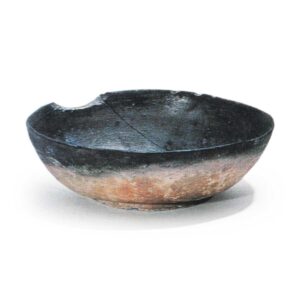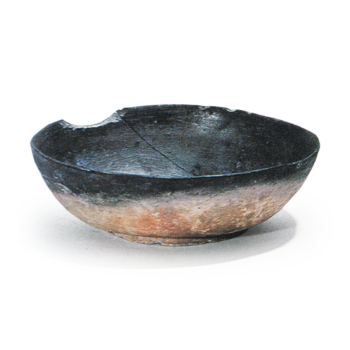
Earthenware of the late Kofun period (6th century) through the Nara and Heian periods that was made black by adsorbing carbon to make the surface denser. Unlike the later tiled vessels, these were fired without the use of a kiln. As for the specific method of blackening, it is a matter of imagination, but as in overseas examples of earthenware customs, it is possible to remove the earthenware while it is still hot after firing and lay it down on a board, or bury it in rice husks or wood chips, or, after firing and cooling, to oil the vessel and burn it, or put leaves in it and burn it. There are two types of earthenware: those in which only the inner surface of the vessel is blackened and those in which both the inner and outer surfaces are blackened, and these are referred to as A and B, respectively. The surfaces to be blackened are usually polished carefully during adjustment. In eastern Japan, black Uchiguro earthenware A and B have existed together since the late Kofun period and are called Uchiguro dojiwares. Excluding the Tokai region, where Sue ware production was active, these vessels are found in abundance, especially in the Shinshu, northern Kanto, and southern Tohoku regions, and include cups, bowls, high cups, and rarely bowls. Black earthenware from eastern Japan is thought to have appeared and become common as an alternative to Sue ware in response to the spread of Sue ware cups as tableware in the Kinai region and western Japan in the 6th century. The oldest known example of black earthenware from the Kinai region was excavated at the Heijo Palace site in 765. Black earthenware in the Kinai region includes many cups, plates, bowls, bowls with a high stand, and bowls for boiling, but steamer, bowls, inkstone, and flat bottles are also rare. There is no particular difference in form between black earthenware and earthenware, and some of them are decorated with whorls of dark patterns after polishing on the inner surface, a technique not found in earthenware. In the 10th century, the number of types of vessels decreased, and bowls and jars with a high stand with a single chink line around the inner surface of the edge of the mouth became more common. At the end of the Nara period, black earthenware A was the predominant type, but by the beginning of the Heian period, black earthenware B was also abundant. The ratio of black earthenware to earthenware is about 5:1 in the late 9th century, but in the first half of the 10th century, the ratio of black earthenware rapidly increases to about 2:1. In the second half of the 11th century, the ratio of black earthenware changed to that of kiln-fired tile ware. The spread of black earthenware in the Kinai region is thought to be closely related to the decline of Sue ware: especially the decrease in the number of offerings. (Yoshihiko Ogasawara, “Tan-nuri-Doshi vessels and black earthenware,” Journal of Archaeological Research, 182)



